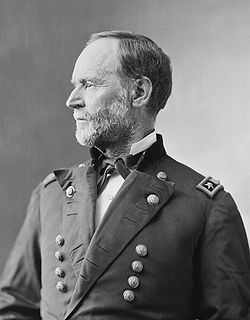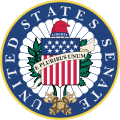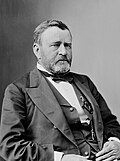J. Donald Cameron
J. Donald Cameron | |
|---|---|
 Cameron c. 1870s | |
| United States Senator from Pennsylvania | |
| In office March 20, 1877 – March 3, 1897 | |
| Preceded by | Simon Cameron |
| Succeeded by | Boies Penrose |
| Chairman of the Republican National Committee | |
| In office November 1, 1879 – July 2, 1880 Acting: November 1, 1879 – December 17, 1879 | |
| Preceded by | Zachariah Chandler |
| Succeeded by | Marshall Jewell |
| 32nd United States Secretary of War | |
| In office May 22, 1876 – March 4, 1877 | |
| President | Ulysses S. Grant |
| Preceded by | Alphonso Taft |
| Succeeded by | George W. McCrary |
| Personal details | |
| Born | James Donald Cameron May 14, 1833 Middletown, Pennsylvania, U.S. |
| Died | August 30, 1918 (aged 85) Lancaster County, Pennsylvania, U.S. |
| Political party | Republican |
| Spouse(s) | Mary McCormick Elizabeth Sherman |
| Children | 7 |
| Education | Princeton University (BA, MA) |
James Donald Cameron (May 14, 1833 – August 30, 1918) was an American banker, businessman and Republican politician who served as Secretary of War in the cabinet of President Ulysses S. Grant from 1876 to 1877 and represented Pennsylvania in the United States Senate from 1877 to 1897. Cameron succeeded his father, Simon Cameron, in both offices and as boss of the powerful Pennsylvania Republican political machine.
Cameron was raised and educated near Harrisburg, Pennsylvania. After graduating from Princeton College, Cameron worked in the banking and railroad industries.
In May 1876, Cameron was appointed Secretary of War as part of a cabinet reshuffle by President Ulysses S. Grant, following the impeachment and resignation of William W. Belknap and a brief tenure by Secretary Alphonso Taft, whom Grant made Attorney General. Cameron's father served in the same office under President Abraham Lincoln.[1][a] During Cameron's tenure, the military was challenged by the Great Sioux War and by the threat of a second Southern secession after the controversial 1876 election of President Rutherford B. Hayes. Cameron proved to be an energetic administrator and his appointment as Secretary of War launched his lengthy political career in the Senate.
After leaving the cabinet, Cameron was elected Senator by the Pennsylvania legislature, under the control of Senator Simon Cameron, his father. Cameron served as Pennsylvania's U.S. Senator from 1877 to 1897, and as chairman on two powerful Senate committees.
After leaving the Senate, Cameron worked in various industrial businesses until his death in 1918. Cameron was the last surviving cabinet member of the Grant Administration.
Early life
James Donald Cameron was born on May 14, 1833, in Middletown, Pennsylvania, in the family home, the first-born son of Simon Cameron, the 26th Secretary of War under President Abraham Lincoln and a powerful Pennsylvania politician. Cameron's mother was Margaret Brua. Cameron was commonly referred to as "Don." Having received his elementary education in Harrisburg, Cameron enrolled in Princeton College (today Princeton University); he graduated with a Bachelor of Arts in 1852 and received a Master of Arts degree in 1855.[2]
Banking and railroad career
After leaving Princeton, Cameron's father Simon placed Cameron as a clerk at the successful Middleton Bank; whose main investments were in the iron, coal, and lumber businesses of Pennsylvania.[2] Cameron worked his way up to being cashier and then president of the bank. As an executive of the Northern Central Railway during the American Civil War, Cameron managed the flow of supplies and soldiers from the northeastern states to Washington, D.C., and Virginia, including efforts to keep the railroad open despite Confederate attempt to damage or destroy it. From 1866 to December 1874 Cameron was president of the Northern Central.[2] As bank president, Cameron was able to improve the financial condition of the railroad. After leaving the Railroad, Cameron worked in various industrial enterprises in Pennsylvania.[2]
Secretary of War

In 1876,
Secretary Cameron requested legislation from Congress that required war contractors be required to stand by their bids for a definite time period.
The U.S. Military, including the Army, headed by Cameron, and Navy, headed by Secretary George M. Robeson, were also in a technological transition developing submarine technology; and torpedo mines and ships to protect United States' waterways and harbors.
Great Sioux War
Without ever holding political office, Secretary of War Cameron had to immediately contend with the

Three battles took place during summer 1876 while Cameron was in charge of the War Department: including the
Presidential election 1876 crisis
After the controversial Presidential election of 1876 the majority of electoral votes for Republican candidate
U.S. Senator
In March 1877, his father resigned his seat in the
Cameron was an active
Cameron was re-elected in 1879, 1885, and in 1891 with his last term ending in March 1897.[13] He was succeeded by Boies Penrose.[13]
Later career
After not being a candidate for reelection in 1896, Cameron engaged in several business enterprises in Harrisburg, Pennsylvania.
Death and burial
Cameron died on August 30, 1918, at his country home called "Donegal" (Cameron Estate) in Lancaster County, Pennsylvania. Cameron was interred at Harrisburg Cemetery in Harrisburg, Pennsylvania. Cameron was the last surviving Cabinet member of the Grant Administration.
Historical reputation
Cameron was part of a political family dynasty started by his father
According to Cameron's biographer Howard Meneely, Cameron "made politics, not statesmanship, his principle public business."[11] However, Meneely admired Cameron for breaking from the rest of his party and opposing the African American 1890 voting rights legislation, "Force Bill", saying that Cameron "showed admirable and courageous independence," and demonstrating the racist tendencies common among historians of the era.[11] Meneely concluded that Cameron was "[t]horoughly honest in personal matters" and "held in high regard by his friends".[11] As a political boss, Cameron "took over the active management" of Pennsylvania's political machine created by his father, and "with the aid of lieutenants like Matthew Quay ran it skillfully and defiantly as long as he remained in public life."[10]
On April 17, 1913, the 17th Amendment was ratified that mandated the popular vote to elect U.S. Senators, rather than being chosen by state legislatures.[14] The Senate by this time was known as a "Millionaires Club" and political machines, such as the one Cameron ran in Pennsylvania, controlled who would be elected Senator.[14]
Marriages, family, and estate
Cameron married Mary McCormick on May 20, 1856, and together they had six children: Eliza McCormick Cameron (born 1857), who married William H. Bradley; Virginia Rolette Cameron (born 1861), who married Lt. Alexander Rodgers; James McCormick Cameron (born 1865); Mary Cameron (born 1867); Margaretta Brua Cameron (born 1869), who married John William Clark; and Rachel Burnside Cameron (born 1871).[15]
Cameron's second wife, the former Elizabeth Sherman, whom he married in 1878, was the niece of
Second wife and two daughters
-
Elizabeth Cameron, second wife of Senator Donald Cameron, Pa, ca. 1890 and ca. 1910
-
Rachel Cameron, daughter of Senator Donald Cameron, Pa, ca. 1896
-
Martha Cameron, daughter of Senator Donald Cameron, Pa, ca. 1896
Donegal

When Cameron died in 1918, his estate, which had been put in trust, was worth $4 million (equivalent to $84 million in 2024).
The Cameron Estate (Donegal) was originally granted by William Penn to James Stephenson, who was the great-great-great-great-grandfather of William McKinley.[18] Cameron's father, Simon Cameron, had purchased the property from Nathanial Watson.[18] Donegal was the home of Cameron's daughter Mary Cameron.[18] In 1961, Cameron's granddaughter, Mary Hale Chase, sold the estate to Elizabethtown College.[18] Charles Baugher, president of the college, designated the property for faculty and student housing, while hosting a satellite campus for special education in collaboration with the Downingtown Special School.[18] In 1979, the college sold the Cameron Estate to a private party.[18] Donegal is currently the Cameron Estate Inn & Restaurant.[19]
See also
- Bibliography of Ulysses S. Grant
Notes
- William H. Taftare the only other father-son duo to serve as United States Secretary of War.
References
- ^ Bell (1981), p. 3-4.
- ^ a b c d e f g New York Times (May 23, 1876), The Presidency
- ^ a b Bell (1981), p. 82.
- ^ M. John Lubetkin, Jay Cooke's Gamble: The Northern Pacific Railroad, the Sioux, and the Panic of 1873 (Norman: University of Oklahoma Press, 2006).
- ^ Griske, p. 64–69.
- ^ Commissioner of Indian Affairs to Secretary of the Interior, January 31, 1876; Secretary of the Interior to the Secretary of War, February 1, 1876; Colonel Drum to Gen. Terry and Gen. Crook, February 8, 1876, National Archives.
- ^ a b c d Meneely (1929), p. 435.
- ^ a b c Cameron (1876), p. 5.
- ^ "Hayes v. Tilden: The Electoral College Controversy of 1876–1877." HarpWeek. Archived February 20, 2006, at the Wayback Machine
- ^ a b Meneely (1929), pp. 435–436.
- ^ a b c d e f g h Meneely (1929), p. 436.
- ^ a b Churella (2013), p. 372.
- ^ a b Johnson (1906), p. 119.
- ^ a b 17th Amendment to the U.S. Constitution: Direct Election of U.S. Senators (1913)
- ^ Center for Pennsylvania Culture Studies. "Mary McCormick". Penn State Harrisburg. Archived from the original on December 2, 2008. Retrieved June 13, 2008.
- ^ Henry Adams, The Education of Henry Adams Chapter XXII Chicago (1893), published in 1918
- ^ a b c New York Times (August 31, 1918), Don Cameron Dies; 20 Years A Senator
- ^ a b c d e f Benowitz & DePuydt (2014), p. 32.
- ^ Cameron Estate Inn & Restaurant (2013)
Sources
- Bell, William Gardner (1981). Secretarys of War and Secretaries of the Army. Washington, DC: US Army, Center of Military History. OCLC 6603916.
- Benowitz, Jean-Paul; DePuydt, Peter J. (2014). Elizabethtown College. ISBN 978-1-4671-2083-8.
- Cameron, J. Donald (November 20, 1876). Annual Report of the Secretary of War. Vol. 1.
- Churella, Albert J. (2013). The Pennsylvania Railroad, Volume 1: Building an Empire, 1846-1917. ISBN 978-0-8122-4348-2.
- Griske, Michael. The Diaries of John Hunton.
- Johnson, Rossiter, ed. (1906). The Biographical Dictionary of America Cameron, James Donald. Boston: American Biographical Society. p. 119.
- Meneely, A. Howard (1929). Allen Johnson (ed.). Dictionary of American Biography Cameron, James Donald. Vol. 3. New York: Charles Scribner's Sons. pp. 435–436.
External links
- United States Congress. "J. Donald Cameron (id: C000065)". Biographical Directory of the United States Congress.
- J. Donald Cameron at Find a Grave
- J. Donald Cameron Biography Archived June 8, 2010, at the Wayback Machine in Secretaries of War and Secretaries of the Army a publication of the United States Army Center of Military History
- Bird's eye view of Cameron's Donegal Estate Bing maps







